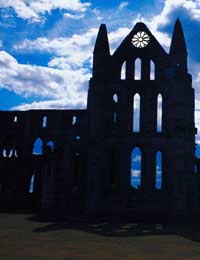Whitby: Where Dracula Walked

The small port town of Whitby on the Yorkshire coast both inspired and played host to the writer Bram Stoker as he worked on his great novel Dracula. Stoker was employed in London as manager of the Lyceum theatre and holidayed frequently in Whitby both before and after the writing of his most famous work.
Whitby in the Dracula Story
Macabre tales from the local fishermen are said to have had a great influence on Stoker and he chose to set part of the novel in the town. It was in Whitby in fact that Dracula first made his arrival on British shores, leaping in the form of a great black dog from the doomed ship Demeter as it crashed on the Whitby shoreline; it was here too that the character Lucy was seduced by Dracula and turned into a vampire herself.While living in Whitby, Stoker picked up several little snippets of knowledge which found their way into his novel. He heard of the Russian schooner Demetrius which, only a few years before, had foundered on the Whitby coast while bearing a cargo of coffins. Corpses in various states of decay washed up on the shore for some time to come. In the novel, Dracula himself travels to Britain on a Russian ship called Demeter which also bears a cargo of coffins. Today there is a memorial on the spot where Stoker is said to have received inspiration for this section of his novel.
The name Dracula also came from what Stoker learned in the Whitby library while researching the history of vampirism. His intention originally had been to call the character Wampyr but, while reading in the library, he came across references to the Hungarian duke Vlad Tepes (also known as Dracula) who fought fiercely against the Turks in the 15th century and was renowned for his brutality. A hand-written footnote in the book said that Dracul meant “Devil” in Hungarian. Something in this seems to have tingled Stoker’s imagination and he changed the name of his character to Dracula.
Whitby Today
Modernity has arrived in Whitby as in everywhere else but its historical character has been rather well preserved, particularly in the cobblestone streets and winding passages of the Old Town. When darkness arrives, standing in certain spots, it is easy to imagine oneself transported back to the nineteenth century and to recapture the sense of foreboding and of vulnerability which led Stoker to choose this location for the scene of Dracula’s arrival on British shores.Whitby has certainly made the most of its dark heritage. Almost every shop and establishment you can think of now boasts some Dracula association. The tourism trade has replaced the fishing industry as the economic mainstay of the town. Among the most compelling of the attractions offered are the Dracula Experience, which retells the classic story through a mixture of music, animation and live actors’ performance; and the Dracula walks which offer a tour of all the Dracula-related spots in the town together with helpful commentary from a local guide. Whitby also has a genuine haunted history as well as a fictional one and another walking tour is available which will give you some insight into the legions of local ghosts.


Re: The Green Lady
I saw a pretty green lady many times outside of my bedroom window. She would smile and beckon me with her hand. I would close the binds and never…
Re: Signs that Your House is Haunted
I have a lot to say about what’s happening in my home. It first started with my newborn, now two, always pointing and talking…
Re: Making Contact With Departed Loved Ones
Hello Team, Hope you are doing great. I feel so curious to know your thought and help you to expand your…
Re: Signs that Your House is Haunted
just moved into new home;its only been about 3 days and things are STRANGE. items i sat down go missing; there is a small…
Re: Signs that Your House is Haunted
This happened two times in continuity at two different places with me. One day the helmet kept in its usual place in an open…
Re: Scottish Folklore: The Brollachan
I read about the Brollachan in The Moon of Gomrath by Alan Garner, and wondered where in the British Isles it originated.…
Re: Signs that Your House is Haunted
I moved in with my boyfriend and he told me about the house being hunted. I've seen stuff and felt like someone is watching…
Re: What to do if You Think You Have a Poltergeist
I'm 15 live in Belgium, in a renovated old house, and once a DVD-Player opened and Closed without someone…
Re: Signs Your Loved One is Possessed
I noticed a big change in my girlfriend and I can only think something dark is attached to her. About 2 years ago she seemed…
Re: What to do if You Think You Have a Poltergeist
Hey guys.. I moved into this 2 and a half appartment about 2 years ago.. I have 2 kids, ages 12 and 4 .. So…